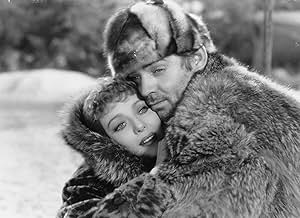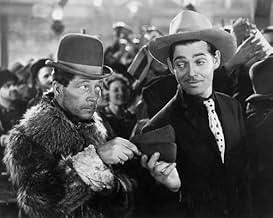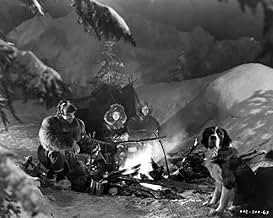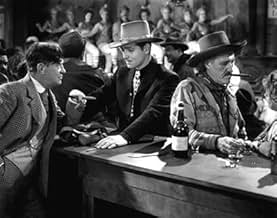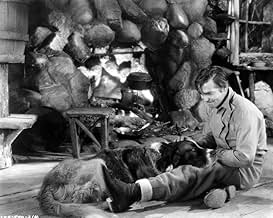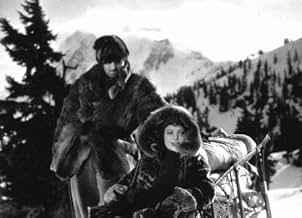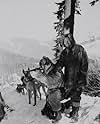NOTE IMDb
6,8/10
2,8 k
MA NOTE
Ajouter une intrigue dans votre langueDuring the Klondike Gold Rush, a traveler purchases a dog to lead the way toward the treasure, but reconsiders his journey when he finds a stranded widow.During the Klondike Gold Rush, a traveler purchases a dog to lead the way toward the treasure, but reconsiders his journey when he finds a stranded widow.During the Klondike Gold Rush, a traveler purchases a dog to lead the way toward the treasure, but reconsiders his journey when he finds a stranded widow.
- Réalisation
- Scénario
- Casting principal
- Récompenses
- 1 victoire au total
Thomas E. Jackson
- 'Tex' Rickard
- (as Tommy Jackson)
George MacQuarrie
- Mounted Policeman
- (as George McQuarrie)
C.E. Anderson
- Fourth Poker Player
- (non crédité)
Edwin Argus
- Dawson Townsman
- (non crédité)
William Arnold
- First Faro Player
- (non crédité)
Avis à la une
THE CALL OF THE WILD (20th Century Pictures, 1935), directed by William A. Wellman, released at the time when classic literature becomes classic cinema, ranks one of the finer Jack London based stories transferred to the screen in spite the fact that it's actually a free adaptation to his classic 1903 novel. In true Hollywood tradition, this version plays like a matinée western, handsome hero, comic sidekick, pretty heroine and nasty villain. Instead of a horse, there's a tough St. Bernard by the name of Buck, who, unlike the novel, is a secondary character, leaving much of the story to its hero, Jack Thornton.
Opening title: "Yukon, 1900, Skagway - mushroom metropolis, the first stop on the long trail to the gold fields." After gambling away his fortune at the gambling tables of The Great Northern where people gather together for wine, liquor and cigars, Jack Thornton (Clark Gable) meets up with his old pal, "Shorty" Houlihan (Jack Oakie). Having served a six month jail sentence for opening another man's letter containing a map to a gold mine compiled by the late Martin Blake, Shorty, who copied the map by memory after destroying the original, invites Thornton to accompany him in the search. Along the way, Thornton acquires vicious St. Bernard named Buck from Joe Groggins (Sidney Toler), saving the animal from being shot by the demanding Mr. Smith (Reginald Owen), whom the dog despises; and Claire (Loretta Young), of San Francisco, camping alone in the woods surrounded by wolves, who happens to be the wife of John Blake, son of the late gold prospector. Blake, who's been missing for a week, is believed to be dead. Not wanting to leave the Blake woman alone in the wild, Thornton takes her with them. Together they form a partnership searching for gold while Blake (Frank Conroy), very much alive, having fallen victim to Smith and his murderous assistants (Charles Stevens and Lalos Encinas) out to get the claim for themselves.
With THE CALL OF THE WILD having been screened earlier by Pathe (1923) with Jack Mulhall; adapted again in 1972 starring Charlton Heston, and a several more in later years, it's the Gable version that's remembered best. Gable, on loan from his home studio of MGM, makes one of the finer Jack London heroes, forceful and confident; and perfect Hollywood leading man by the way of romance. Buck, having little to do plot-wise, serves the film's purpose with a key scene in the Dawson City sequence where he pulls a thousand pound load sled through the cheering crowd of spectators a hundred yards on slippery snow towards his calling master as part of a $1,000 bet Thornton made with Smith. Aside from fine chemistry between Gable and Young (who worked together again in the 1950 MGM comedy, KEY TO THE CITY), Buck has his call of the wild with a female dog companion as well.
Anyone reading the closing cast credits will notice that Katherine DeMille, listed for the role of Marie, is non-existent in the final print. According to Bob Dorian, former host of American Movie Classics, during one of its many broadcasts during the 1990s, mentioned that DeMille's scenes were cut after its initial premiere due to her questionable character, reducing its original 95 minute length to 81, where it has been since. It's believed her character appeared during the latter portion of the opening saloon sequence, prior to Thornton's purchase of Buck, which explains the immediate cut from one scene to another. As it stands now, no prints involving "Marie" exists today. What has survived, according to an episode of the 1970s TV documentary, "That's Hollywood," narrated by Tom Bosley, is a cut scene involving Smith's shooting Shorty over a gambling debt. Because audiences couldn't accept comedian Jack Oakie getting killed, it was cut with Oakie's scenes rewritten. Unlike most movies at that time, filmed mostly inside the studio set, THE CALL OF THE WILD ads touches of realism with its location shooting in the Washington State mountains. Rumor has it that freezing temperatures caused production delays. Overall, THE CALL OF THE WILD is best noted for the off-screen romance chemistry between Gable and Young, as profiled during A&E's "Biography" on either Gable or Young.
Of all the Gable movies placed on VHS and DVD, it's a wonder why THE CALL OF THE WILD was never distributed on home video, considering its popularity due to frequent commercial TV revivals in the 1960s, 70s and 80s, unlike the now forgotten WHITE FANG (20th-1936), another Jack London based story transferred to the screen. Starring Michael Whalen and Jean Muir, it's opening titles read "A sequel to "The Call of the Wild." Aside from the title character being an offspring of Buck, and no sign of Clark Gable's Jack Thornton, there is a villain in the story named "Beauty" Smith, as portrayed by John Carradine, but not the same Smith wonderfully portrayed by Owen. Besides its former broadcasts on American Movie Classics prior to 2005, THE CALL OF THE WILD has also appeared on the Fox Movie Channel and Turner Classic Movies (TCM premiere: November 7, 2012)(***)
Opening title: "Yukon, 1900, Skagway - mushroom metropolis, the first stop on the long trail to the gold fields." After gambling away his fortune at the gambling tables of The Great Northern where people gather together for wine, liquor and cigars, Jack Thornton (Clark Gable) meets up with his old pal, "Shorty" Houlihan (Jack Oakie). Having served a six month jail sentence for opening another man's letter containing a map to a gold mine compiled by the late Martin Blake, Shorty, who copied the map by memory after destroying the original, invites Thornton to accompany him in the search. Along the way, Thornton acquires vicious St. Bernard named Buck from Joe Groggins (Sidney Toler), saving the animal from being shot by the demanding Mr. Smith (Reginald Owen), whom the dog despises; and Claire (Loretta Young), of San Francisco, camping alone in the woods surrounded by wolves, who happens to be the wife of John Blake, son of the late gold prospector. Blake, who's been missing for a week, is believed to be dead. Not wanting to leave the Blake woman alone in the wild, Thornton takes her with them. Together they form a partnership searching for gold while Blake (Frank Conroy), very much alive, having fallen victim to Smith and his murderous assistants (Charles Stevens and Lalos Encinas) out to get the claim for themselves.
With THE CALL OF THE WILD having been screened earlier by Pathe (1923) with Jack Mulhall; adapted again in 1972 starring Charlton Heston, and a several more in later years, it's the Gable version that's remembered best. Gable, on loan from his home studio of MGM, makes one of the finer Jack London heroes, forceful and confident; and perfect Hollywood leading man by the way of romance. Buck, having little to do plot-wise, serves the film's purpose with a key scene in the Dawson City sequence where he pulls a thousand pound load sled through the cheering crowd of spectators a hundred yards on slippery snow towards his calling master as part of a $1,000 bet Thornton made with Smith. Aside from fine chemistry between Gable and Young (who worked together again in the 1950 MGM comedy, KEY TO THE CITY), Buck has his call of the wild with a female dog companion as well.
Anyone reading the closing cast credits will notice that Katherine DeMille, listed for the role of Marie, is non-existent in the final print. According to Bob Dorian, former host of American Movie Classics, during one of its many broadcasts during the 1990s, mentioned that DeMille's scenes were cut after its initial premiere due to her questionable character, reducing its original 95 minute length to 81, where it has been since. It's believed her character appeared during the latter portion of the opening saloon sequence, prior to Thornton's purchase of Buck, which explains the immediate cut from one scene to another. As it stands now, no prints involving "Marie" exists today. What has survived, according to an episode of the 1970s TV documentary, "That's Hollywood," narrated by Tom Bosley, is a cut scene involving Smith's shooting Shorty over a gambling debt. Because audiences couldn't accept comedian Jack Oakie getting killed, it was cut with Oakie's scenes rewritten. Unlike most movies at that time, filmed mostly inside the studio set, THE CALL OF THE WILD ads touches of realism with its location shooting in the Washington State mountains. Rumor has it that freezing temperatures caused production delays. Overall, THE CALL OF THE WILD is best noted for the off-screen romance chemistry between Gable and Young, as profiled during A&E's "Biography" on either Gable or Young.
Of all the Gable movies placed on VHS and DVD, it's a wonder why THE CALL OF THE WILD was never distributed on home video, considering its popularity due to frequent commercial TV revivals in the 1960s, 70s and 80s, unlike the now forgotten WHITE FANG (20th-1936), another Jack London based story transferred to the screen. Starring Michael Whalen and Jean Muir, it's opening titles read "A sequel to "The Call of the Wild." Aside from the title character being an offspring of Buck, and no sign of Clark Gable's Jack Thornton, there is a villain in the story named "Beauty" Smith, as portrayed by John Carradine, but not the same Smith wonderfully portrayed by Owen. Besides its former broadcasts on American Movie Classics prior to 2005, THE CALL OF THE WILD has also appeared on the Fox Movie Channel and Turner Classic Movies (TCM premiere: November 7, 2012)(***)
Gable has it all for a short while: easy pickings gold nuggets, a gorgeous girlfriend he found in the wilderness, a half-wild soul mate lead dog and a bashful wisecracking partner. But, his grasp on all of these is slippery, as the plot develops. I don't fault Hollywood for departing so flagrantly from London's story, which too was just a yarn. I found this version much more entertaining and profound, despite the stereotypical boss-sidekick relationship between Gable and Jack Oakie.
Gable seems to represent sort of an ideal adventurous entrepreneur: a riverboat gambler at heart, who is willing to take big risks and to work for his fortune when necessary, but who tries to grab all he can and beat out the competition. The chief villain is a stereotypical pretentious cutthroat tycoon: the worst kind of capitalist. In contrast, Gable recognizes certain limits in gaining his fortune and honors his commitments to his partners, be they human or animal. Loretta's creed is yet more tempered: You will get what you want only if you deserve it. See the movie to find out how these various creeds interact to determine the outcome.
This is perhaps Gable's most enjoyable role, along with those in "Mutiny on the Bounty" and "Boom Town". As in most of his best roles, Gable comes across as rakish: part hero, part scoundrel, but never dull. Like Gable, Loretta is at her physical peak at this time, making for a very romantic-looking couple.
Gable seems to represent sort of an ideal adventurous entrepreneur: a riverboat gambler at heart, who is willing to take big risks and to work for his fortune when necessary, but who tries to grab all he can and beat out the competition. The chief villain is a stereotypical pretentious cutthroat tycoon: the worst kind of capitalist. In contrast, Gable recognizes certain limits in gaining his fortune and honors his commitments to his partners, be they human or animal. Loretta's creed is yet more tempered: You will get what you want only if you deserve it. See the movie to find out how these various creeds interact to determine the outcome.
This is perhaps Gable's most enjoyable role, along with those in "Mutiny on the Bounty" and "Boom Town". As in most of his best roles, Gable comes across as rakish: part hero, part scoundrel, but never dull. Like Gable, Loretta is at her physical peak at this time, making for a very romantic-looking couple.
Wiliam Wellman is the director at the helm of this version of Jack London's immensely popular novel. As an adventure, this movie offers a lot of fun because of the enormous appeal of its star, Clark Gable. He is a man's man. Mr. Gable projected such an aura about himself that he carried from film to film, making him one of the favorites of all audiences. The gold rush is presented as it should have been for the people that went in search of riches in the inhospitable confines of Alaska.
In this version, Loretta Young plays Claire Blake, the woman who conquered Jack Thornton's heart. The rumored affair between Ms. Young and Mr. Gable is fun to look at. What's real, and what not? It's up to the stars to know and for us, the viewers, to guess. Ms. Young and Mr. Gable were appealing players, as they prove in this film.
In other roles, Jack Oakie, Reginald Owen, Frank Conroy, and other old faces from films of the era make wonderful appearances. Above all, Buck, the great St. Bernard dog in the film is amazing. It's a joy to watch Mr. Gable's scenes with Buck as they compliment one another in that frigid background.
In this version, Loretta Young plays Claire Blake, the woman who conquered Jack Thornton's heart. The rumored affair between Ms. Young and Mr. Gable is fun to look at. What's real, and what not? It's up to the stars to know and for us, the viewers, to guess. Ms. Young and Mr. Gable were appealing players, as they prove in this film.
In other roles, Jack Oakie, Reginald Owen, Frank Conroy, and other old faces from films of the era make wonderful appearances. Above all, Buck, the great St. Bernard dog in the film is amazing. It's a joy to watch Mr. Gable's scenes with Buck as they compliment one another in that frigid background.
Jack London's novel The Call Of The Wild is pretty much ignored in this 1935 adaptation. The title remains the same and there IS a dog named Buck involved in parts of the action, but apart from that the similarities are virtually non-existent. Far greater emphasis is placed on the human characters in the film than in the book. One has to assume that the film was written as a vehicle for Clark Gable, a big outdoor adventure yarn in which the star could get in to and out of a variety of hair-raising escapades in the frozen wilderness. The fact that London's novel is essentially an animal story with a few human characters passing through the narrative is of little significance to scripter Gene Fowler and director William Wellman. That's not to say The Call Of The Wild is a disposable film; the unusual and expensive decision to film on genuinely cold, mountainous locations (Washington state standing in for Yukon) shows that this was envisaged as a serious box office winner.
Struggling gold prospector Jack Thornton (Gable) and his goofy sidekick Shorty Hooliham (Jack Oakie) travel around the Yukon in the 19th Century, searching for an elusive gold strike that will make them richer than rich. They are helped in their adventures by a St Bernard dog named Buck. Also busily scouring the land for gold is the sinister English-man Smith (Reginald Owen), a cruel rival who has a mysterious past and even a little history with Thornton's dog. During their wanderings, Jack and Shorty come across a woman called Claire Blake (Loretta Young) whose husband has gone missing in the snowfields and could be dead. Claire teams up with Jack, Shorty and Buck, but it isn't long before she finds herself falling for Thornton's roguish charm, even though she cannot be sure if her husband is dead or alive.
The movie is very enjoyable in its old-fashioned way. I'm a believer in the theory that films should try to be faithful to their source material, at least to a reasonable extent, so in some ways I felt dismayed at the lack of respect towards London's original story. However, once I'd got that small irritation out of my system I found The Call Of The Wild a perfectly likable star vehicle. Gable is solid in a role that asks little of him other than to appear rugged and fearless. Owen is very good as the villain of the piece, while Young shares a good chemistry with the hero (in real-life, she and Gable were lovers). Jack Oakie is the least impressive of the key actors, mugging rather embarrassingly as the inevitable comical sidekick. The location work in Washington state adds a sense of authenticity to the film that is very uncommon for a movie made in the studio-bound '30s. On the negative side, though, the film settles for a very convenient ending which ditches plausibility so that the course of true love and personal success can run smoothly (indeed, IMPROBABLY smoothly) for the main protagonists. Of its type and era, however, The Call Of The Wild is watchable and entertaining fare.
Struggling gold prospector Jack Thornton (Gable) and his goofy sidekick Shorty Hooliham (Jack Oakie) travel around the Yukon in the 19th Century, searching for an elusive gold strike that will make them richer than rich. They are helped in their adventures by a St Bernard dog named Buck. Also busily scouring the land for gold is the sinister English-man Smith (Reginald Owen), a cruel rival who has a mysterious past and even a little history with Thornton's dog. During their wanderings, Jack and Shorty come across a woman called Claire Blake (Loretta Young) whose husband has gone missing in the snowfields and could be dead. Claire teams up with Jack, Shorty and Buck, but it isn't long before she finds herself falling for Thornton's roguish charm, even though she cannot be sure if her husband is dead or alive.
The movie is very enjoyable in its old-fashioned way. I'm a believer in the theory that films should try to be faithful to their source material, at least to a reasonable extent, so in some ways I felt dismayed at the lack of respect towards London's original story. However, once I'd got that small irritation out of my system I found The Call Of The Wild a perfectly likable star vehicle. Gable is solid in a role that asks little of him other than to appear rugged and fearless. Owen is very good as the villain of the piece, while Young shares a good chemistry with the hero (in real-life, she and Gable were lovers). Jack Oakie is the least impressive of the key actors, mugging rather embarrassingly as the inevitable comical sidekick. The location work in Washington state adds a sense of authenticity to the film that is very uncommon for a movie made in the studio-bound '30s. On the negative side, though, the film settles for a very convenient ending which ditches plausibility so that the course of true love and personal success can run smoothly (indeed, IMPROBABLY smoothly) for the main protagonists. Of its type and era, however, The Call Of The Wild is watchable and entertaining fare.
Clark Gable meets Loretta Young in this 1930s adaptation of Jack London's The Call of the Wild, which takes place in Alaskan territory. I've never read the book, but I can only imagine that this was probably not very faithful to the novel, due to its emphasis of comic relief by supporting actor Jack Oakie. This is the movie that changed Clark and Loretta's life, as they fell in love during the making of this film, and she went away in private to have his baby - a fact she never told the public. While that may be neither here nor there, in reviewing this film, it's pretty evident that something was going on, by their quiet scenes together, which are very intimate and deep, considering this is a 1930s film. The plot revolves around a map that is needed to find a gold mine. Her husband, yes her husband, was the owner of the map, but Clark and Jack go after the gold mine, with Jack's memory and a rough sketch of it to use. They find Loretta alone, after her husband has been lost in the wilderness looking for help. Reginald Owen is very good and memorable as a nemesis in trying to find the gold mine too, when he learns of it. The production values and performances are solid and deliver the goods, but its corny comic relief mars the film's attempt to hit the mark with viewers, especially with its abrupt ending. I thought the novel was mainly about the dog, but, while the dog, who Clark is attached to, does have some screen time, the film doesn't feel like a dog film. The producers were probably thinking that would alienate some viewers, so they centered on pairing attractive leads Clark and Loretta together and Jack Oakie's one-liners. While I liked the film on the whole for Loretta's loveliness, memorable love scenes between her and Clark, and Reginald Owen's credible contribution to the film, I still feel it misses the mark for a completely fulfilling movie experience.
Le saviez-vous
- AnecdotesLike many films of the era, this production was originally slated to film in the Southern Sierra Nevada near Sonora. In fact, production had already begun when a warm front melted the snow and forced a hasty and expensive move to Washington state.
- GaffesWhy call this a goof? It's just a funny way of saying he'd knife someone.
- Citations
Jack Thornton: Me? I'll take bourbon. It kills you slower, but a lot more pleasant like.
- Versions alternativesOriginally released at 95 minutes; later cut to 81 minutes for a re-issue. For many years only the cut re-issue version was available for television showings, and it is also the version released on DVD in 2006 as part of the Clark Gable Collection. The original length version remained unseen until it was released on blu-ray in 2013.
- ConnexionsFeatured in Ta mère ou moi ! (1991)
Meilleurs choix
Connectez-vous pour évaluer et suivre la liste de favoris afin de recevoir des recommandations personnalisées
- How long is Call of the Wild?Alimenté par Alexa
Détails
- Date de sortie
- Pays d’origine
- Langues
- Aussi connu sous le nom de
- Un grito en la selva
- Lieux de tournage
- Société de production
- Voir plus de crédits d'entreprise sur IMDbPro
- Durée1 heure 35 minutes
- Couleur
- Mixage
- Rapport de forme
- 1.37 : 1
Contribuer à cette page
Suggérer une modification ou ajouter du contenu manquant


